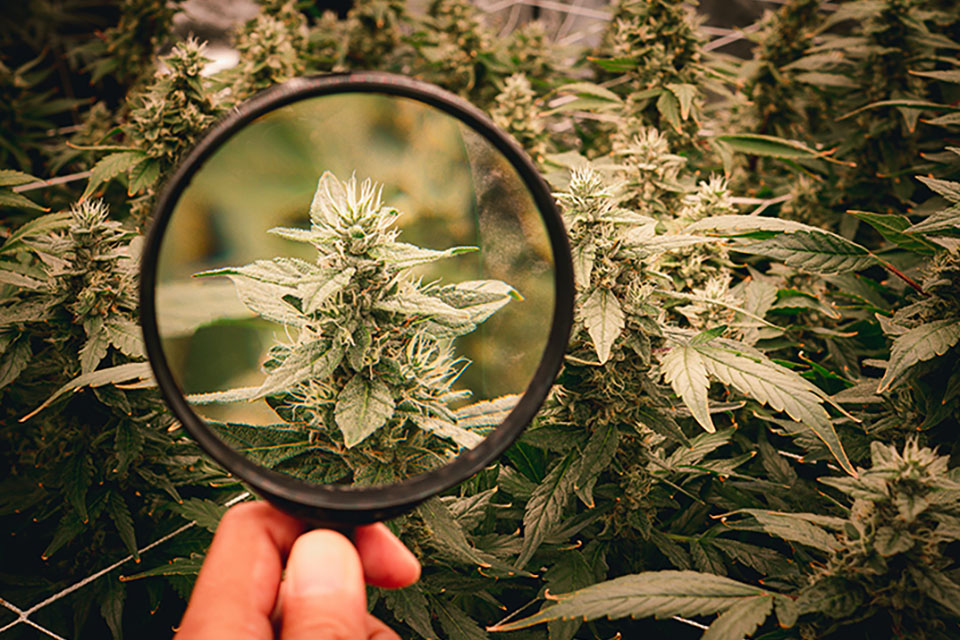
Not all forms of stress are bad for plants—in fact, some growers intentionally stress cannabis plants to accelerate growth, maximize yield, and bolster their resistance to disease. However, some types and levels of stress can have detrimental and even fatal effects. Here, we’ll look at some of the most common causes of stress in cannabis plants, as well as a few common-sense solutions.
Over- or Underwatering
Cannabis growers know that excessive watering is bad, but too little water can be just as harmful. Over- and underwatering plants can cause their leaves to wilt, curl, and become discolored. When plants are overwatered, their roots are cut off from nutrient and oxygen supplies; when they don’t get enough water, they’ll simply shrivel up.
It’s quite common for new cultivators to water their plants overenthusiastically. After all, cannabis plants are 80% water! Plants in different geographical locations and soil types have varying water needs, so there’s no way to offer a universal watering recommendation. Before creating a watering cycle, check the soil’s drainage by digging a hole 12 inches deep and filling it with water. If it takes more than an hour to be absorbed, drainage is inadequate.
Cannabis plants, even those grown from cheap seeds, give certain signs when they’re over- or underwatered. For instance, if the lower foliage looks limp, the plants may need more water. Check the soil at a depth of five centimeters; if it’s dry, add water gradually until the soil is moist. Use room temperature water at a pH of 5.6 to 5.8 during vegetation and increase the pH slightly during the flowering stage.
Over- and Underfeeding
Plant stress from an insufficiency or an excess of nutrients is another problem among cannabis growers. It’s important to give the plants what they need, but not so much that they can’t process it all. Nutrient-related stress brings on all kinds of problems, from spotted and discolored leaves to slow growth. A nutrient surplus can also attract bothersome insects.
NPK, or nitrogen, phosphorus, and potassium, are the most important nutrients to consider. When you buy nutrient blends for cannabis plants, you’ll typically see the NPK ratio on the package. If you’re using high-quality soil, let the plants absorb those nutrients for the first several weeks before doing any supplemental feeding.
Once the plants’ leaves start to open, choose a nutrient blend that’s rich in nitrogen and potassium. As they reach the flowering phase, you’ll need less nitrogen and more phosphorus. While potassium increases the number of flowers on each plant, potassium makes them heavier. If plants get too much nitrogen during flowering, it may result in stunted bud growth and a bad-tasting product.
PH Stress
For optimal growth, cannabis plants need the right soil and nutrient solution pH. If the pH is too high or too low, the plants won’t be able to absorb nutrients even if they’re present in the right quantities. Not only will improper pH bring nutrient deficiencies and growth problems, but it will also cause root burn.
The growth medium you choose will have a significant effect on growth and crop yield. Loamy soil is a great option because it is a mixture of silt, sand, and clay. It drains well, has plenty of room for air, and offers high yields.
While loamy soil is ideal, it’s still important to ensure that the soil is at the right pH so the plants’ roots can absorb nutrients properly. Generally, cannabis plants need a soil pH of 6.0 to 6.5. A pH of 7.0 is considered mid-range, while higher numbers are alkaline and lower numbers are acidic. When checking the pH of the soil, don’t forget to check that of the nutrient blend you’re using.
Light Stress
While these plants are tough and resilient, they won’t thrive in unsuitable environments. Cannabis plants require a certain level and quality of light; when they don’t get enough, they won’t reach their full potential.
Lighting isn’t a big issue for outdoor cultivators because the plants get natural light. However, indoor growers must keep their plants on a strict lighting schedule, which will change as growth progresses. For instance, the plants may need up to 24 hours of light during vegetation, while they’ll need 12 hours of light and 12 hours of darkness when flowering.
When cannabis plants aren’t on a consistent light cycle, they tend to get confused. It’s crucial that the darkness cycle isn’t interrupted, as even the smallest amount of light can stress the plants into re-entering the vegetative phase. This will adversely affect growth and overall yield.
Putting grow lights too close to or too far away from the plants will cause stress, and the buds near the bottom of the plants may not get enough light. When planning an indoor grow, be sure to design the lighting to offer the appropriate level of exposure.


Stress From Tissue and Root Damage
Slight damage to leaves and branches isn’t a big concern, as cannabis plants can handle these occurrences rather well. However, when stress is constant, the effects are more pronounced—and your plants will spend more time recovering than growing.
Root damage is more worrisome, as the plants use their roots to absorb oxygen and nutrients. Stress and damage to the roots caused by infection, mold growth, poor lighting, or physical damage can affect plant growth. For outdoor crops, containers that get hot can create problems, as can root rot and mold. These issues may occur when the soil’s drainage is so poor that oxygen can’t get to the root zone. Avoid root and tissue damage by ensuring good soil drainage and managing temperatures to the extent possible.
Environmental Stress
If you’re at ease in your surroundings, your plants will be, too. Environmental extremes, such as excessive humidity and temperature fluctuations, can cause undue stress to cannabis plants. While the occasional environmental stressor isn’t a cause for concern, it’s important to give your plants a consistent, comfortable environment in which they can grow and thrive.
Cannabis plants will become stressed in any room where it’s too hot, too cold, or too humid. For indoor grows, cultivators must be aware of the right humidity and temperature ranges for every stage of the cannabis plant’s life cycle—from seed to bud.
Seedlings need:
- A humidity level of 65 to 70% so the plants can absorb water via their leaves
- A temperature ranging from 68 to 76 degrees Fahrenheit (be sure to lower that temperature by five to eight degrees during the dark portion of the light cycle)
Vegetating plants need:
- A humidity level that’s dropped by 5% each week to between 40% and 70%
- A temperature range of 70 to 80 degrees Fahrenheit (drop it by five to eight degrees during dark periods)
Under these conditions, the plants’ roots will absorb more water and cool themselves via evaporation through the leaves.
Flowering plants require:
- A lower humidity level of 40 to 50%
- A temperature between 68 and 78 degrees Fahrenheit (the lower end of the range is safest)
About two weeks before the harvest, drop the grow room’s humidity so it’s at about 30 to 40% and reduce the temperature to approximately 65 degrees. If the humidity gets too high at any time, use a dehumidifier and water the plants directly during the photoperiod. Increase humidity by misting the plants, keeping the soil’s surface moist, and using a humidifier when required.
Lower the grow room’s temperature by installing an AC unit, keeping the lights off during daytime hours, and increasing airflow. Raise the temperature by using more powerful grow lights or installing heating mats on the floor. Keep in mind, though, that overheated plants can become so stressed that they may not recover, while frigid plants will show signs such as discoloration and stunted growth.
Stress Prevention: It’s Hard Work
If you’re growing marijuana for the first time, be prepared for a lot of research and hard work. Your crop’s health and abundance are determined by the surroundings in which it’s grown. Factors like light, air quality, temperature, and humidity decide whether you’ll have great or mediocre results.
While a little stress is beneficial, too much can result in a condition known as hermaphroditism. When a cannabis plant shows the reproductive characteristics of both genders, they won’t just pollinate themselves—they’ll also affect other plants. Pollinated plants produce seedy buds of poor quality, and it only takes one hermaphroditic plant to ruin an entire crop.
Closing Thoughts on Cannabis Plant Stress and Its Prevention
The best way to minimize stress in cannabis plants is to avoid extremes in the cultivation environment. While our guide offers tips on ideal humidity, soil pH, water, nutrients, light levels, and temperature—these guidelines are broad and by no means universal.
Even if you’re following our recommendations, it’s important to monitor your crop for signs of excessive stress. The sooner these problems are identified, the easier they are to resolve. Don’t wait too long to act; otherwise, the quality, size, and taste of your buds will be affected. A healthy and stress-free plant is a happy one that will offer sweet, sticky buds—and that’s why we’re all here, isn’t it? The best crops begin with the highest quality seeds, and you can count on the team here at kindseed.com to offer the best prices and selection. Visit us today to get started on your next bumper crop!






